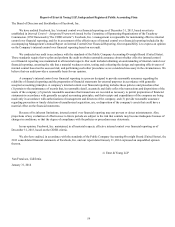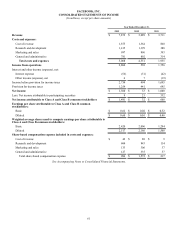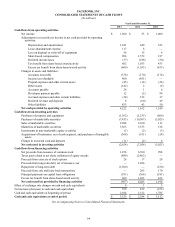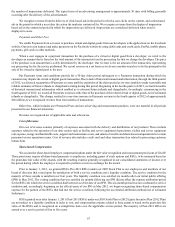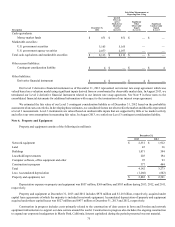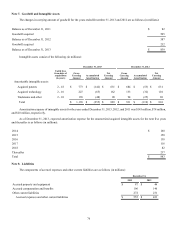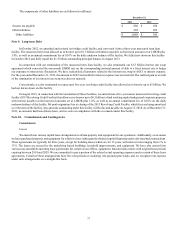Facebook 2013 Annual Report Download - page 69
Download and view the complete annual report
Please find page 69 of the 2013 Facebook annual report below. You can navigate through the pages in the report by either clicking on the pages listed below, or by using the keyword search tool below to find specific information within the annual report.67
the number of impressions delivered. The typical term of an advertising arrangement is approximately 30 days with billing generally
occurring after the delivery of the advertisement.
We recognize revenue from the delivery of click-based ads in the period in which a user clicks on the content, and action-based
ads in the period in which a user takes the action the marketer contracted for. We recognize revenue from the display of impression-
based ads in the contracted period in which the impressions are delivered. Impressions are considered delivered when an ad is
displayed to users.
Payments and Other Fees
We enable Payments from our users to purchase virtual and digital goods from our developers with applications on the Facebook
website. Our users can transact and make payments on the Facebook website by using debit cards and credit cards, PayPal, mobile phone
payments, gift cards or other methods.
When a user engages in a payment transaction for the purchase of a virtual or digital good from a developer, we remit to the
developer an amount that is based on the total amount of the transaction less the processing fee that we charge the developer. The price
of the purchase is an amount that is solely determined by the developer. Our revenue is the net amount of the transaction, representing
our processing fee for the service performed. We record revenue on a net basis as we do not consider ourselves to be the principal in the
sale of the virtual or digital good to the user.
Our Payments terms and conditions provide for a 30-day claim period subsequent to a Payments transaction during which the
customer may dispute the virtual or digital goods transaction. Due to lack of historical transactional information, through the third quarter
of 2012, we deferred recognition of Payments revenue until the expiration of the claim period as we were unable to make reasonable and
reliable estimates of future refunds or chargebacks arising during this period. Beginning in the fourth quarter of 2012, we had 24 months
of historical transactional information which enabled us to estimate future refunds and chargebacks. Accordingly, commencing in the
fourth quarter of 2012, we record all Payments revenues at the time of the purchase of the related virtual or digital goods, net of estimated
refunds or chargebacks. This change resulted in a one-time increase in Payments revenue in the fourth quarter of 2012 of approximately
$66 million as we recognized revenue from four months of transactions.
Other fees, which includes user Promoted Posts and our ad serving and measurement products, were not material in all periods
presented in our financial statements.
Revenue is recognized net of applicable sales and other taxes.
Cost of Revenue
Our cost of revenue consists primarily of expenses associated with the delivery and distribution of our products. These include
expenses related to the operation of our data centers such as facility and server equipment depreciation, facility and server equipment
rent expense, energy and bandwidth costs, support and maintenance costs, and salaries, benefits and share-based compensation for certain
personnel on our operations teams. Cost of revenue also includes credit card and other transaction fees related to processing customer
transactions.
Share-based Compensation
We account for share-based employee compensation plans under the fair value recognition and measurement provisions of GAAP.
Those provisions require all share-based payments to employees, including grants of stock options and RSUs, to be measured based on
the grant-date fair value of the awards, with the resulting expense generally recognized in our consolidated statements of income over
the period during which the employee is required to perform service in exchange for the award.
Prior to January 1, 2011, we granted RSUs (Pre-2011 RSUs) under our 2005 Stock Plan to our employees and members of our
board of directors that vested upon the satisfaction of both a service condition and a liquidity condition. The service condition for the
majority of these awards is satisfied over four years. The liquidity condition was satisfied six months after our initial public offering
(IPO) in May 2012. The vesting condition that was satisfied six months following our IPO did not affect the expense attribution period
for the RSUs for which the service condition had been met as of the date of our IPO. This six-month period was not a substantive service
condition and, accordingly, beginning on the effectiveness of our IPO in May 2012, we began recognizing share-based compensation
expense for the portion of the RSUs that had met the service condition, following the accelerated attribution method (net of estimated
forfeitures).
RSUs granted on or after January 1, 2011 (Post-2011 RSUs) under our 2005 Stock Plan or 2012 Equity Incentive Plan (2012 Plan)
are not subject to a liquidity condition in order to vest, and compensation expense related to these grants is based on the grant date fair
value of the RSUs and is recognized on a straight-line basis over the applicable service period. The majority of Post-2011 RSUs are
earned over a service period of four to five years.




